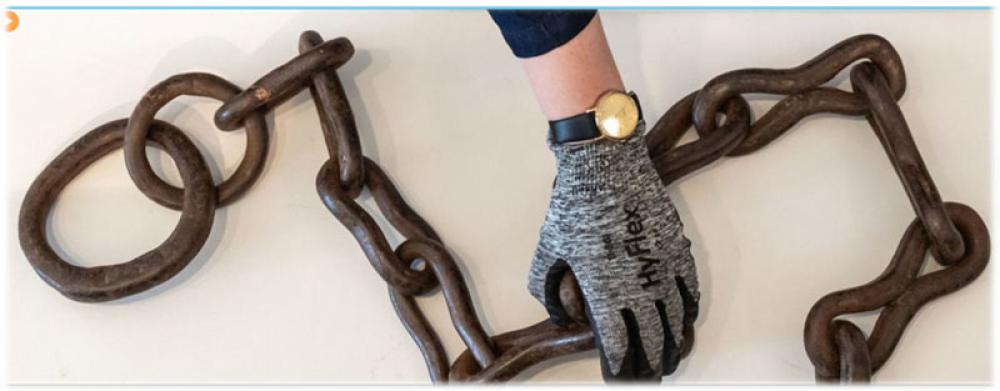Just Earth News | @justearthnews | 05 Mar 2023, 09:37 pm Print

Richard Koek
New York: A grain of rice, a golden collar, and a three-metre-long heavy wooden brace to trap ankles and necks shape part of a unique, interactive exhibit on slavery that just opened at UN Headquarters.
With myriad objects casting a new light on some of the darkest pages of history, Slavery: Ten True Stories of Dutch Colonial Slavery has been brought to the UN by Amsterdam’s Rijksmuseum.
“It’s baffling to me that there are a lot of countries still apologizing for slavery,” Daniela Paredes,18, from Cancun, Mexico, told UN News following a class visit. “Governments are working to not overlook slavery and how it’s present today. It shows it is possible for society to learn from our mistakes. It gives me hope for humanity.”
The exhibit tethers around a single artefact: a heavy wooden plank brace, known as a “tronco” – Portuguese for tree trunk. Used to restrain enslaved people for sleeping or corporal punishment to prevent their escape, the sinister contraption – carbon dated to between 1700 and 1850 ¬ was discovered in the 1960s in a barn in Zeeland, a town in the Netherlands.
The tronco remains a stark material reminder that 15 million men, women, and children were victims of a heinous legalized system for centuries, said the UN Outreach Programme on the Transatlantic Slave Trade and Slavery, established by the General Assembly in 2007, which coordinated the event.
“Bringing the exhibit here to the UN connects it all,” Valika Smeulders, one of the exhibit’s four curators and head of history at the museum, told UN News. “We thought it would be important that the Netherlands comes to terms with the fact that it has had a major role in colonial history. We wanted to connect everybody in the Netherlands to that larger story by making the exhibition really personal.”
Ms. Paredes’ classmate, Alexa Bejar, 17, marvelled at learning about the world through the exhibit’s zoom lens.
“It is amazing that governments and countries are willing to talk openly and truthfully,” she said.
Profiteers to freedom fighters
Surrounding the tronco, interactive panels tell the stories of people hailing from Bangladesh, Brazil, Netherlands, South Africa, Suriname, and the Caribbean and West African regions, intertwined with the Dutch slave trade, which trapped about one million people across the world into slavery between the seventeenth and nineteenth centuries.
Visitors can swipe QR codes on each of the panels, to link to present-day recordings of descendants and others who are connected to profiteers, victims, and freedom fighters. Meticulously “researched and re-researched”, Ms. Smeulders said the stories were produced by a bevy of experts, including historians, a theatre director, interior designer, artists, and a biologist who conducted DNA analysis.
However, the curators had a hard time choosing just 10 stories out of the more than a million, she said.
“There are millions of stories, of course, but what we wanted the 10 stories to give an insight into the system,” she said.
From the lifestyles of the rich to the flight to freedom, the exhibit tells the story of Surapti, from Indonesia, who went from enslavement to freedom fighter. Another explains that Oopjen, the frothily enlaced wife of a Dutch sugar magnate who profited from slavery, had her portrait painted by Rembrandt himself.
Then there is the brave Sapani, who hid in her plaited hair tiny grains of rice indigenous to West Africa when she was forced onto a ship sailing to Suriname. Fleeing enslavement at a plantation, she used those seeds, which became a critical food source in newly established communities and a symbol of hard-won freedom.
‘Not just about history’
The exhibit comes at a time when world leaders are reckoning with the colonial past, trying to make amends by, among other things, repatriating artefacts looted in the colonial era. Dutch Prime Minister Mark Rutte in December issued a formal apology for the country’s role in the slave trade.
“It’s not just about history; it’s also about our common future,” Ms. Smeulders said. “The legacy of slavery is among us every day. We need to address that, especially all the types of discrimination and racism that are still around.”
To have that conversation going on here at the UN and having the exhibit as a ‘talking stick’ to continue that conversation “is really important to us”, she said.
“Part of the solution is to recognize that it is connected to that past and that by understanding the past, we understand today’s society as well,” she added.
At the exhibit’s opening, Melissa Fleming, head of the UN Department of Global Communications, who hosted the event, said teaching, learning, and understanding this history “helps us in our work to end racism and injustice and to build inclusive societies based on dignity and human rights for all.”
- New form of 'religious fascism': Bangladesh students, cultural activists protest arrest of Baul singer for hurting religious sentiments
- NY Mayor-elect Mamdani backs Starbucks strike: 'No Contract, No Coffee'
- Unprecedented housing emergency hits Ukraine — Millions struggle for shelter amid ongoing conflict against Russia
- Israel-Hamas crisis: Nearly every child is showing signs of trauma after years of conflict in Gaza, shows report
- Baloch Martyrs’ Day in Berlin: Activists slam Pakistan, demand ‘Free Balochistan’



-1763561110.jpg)


